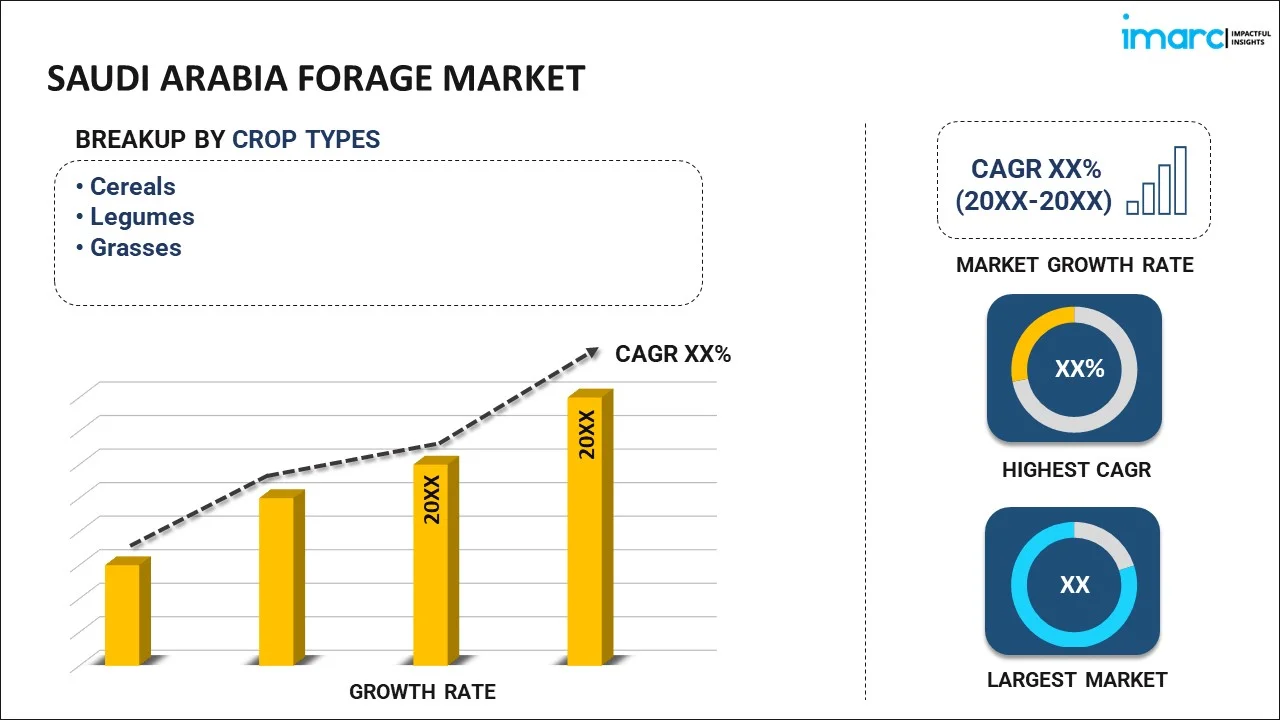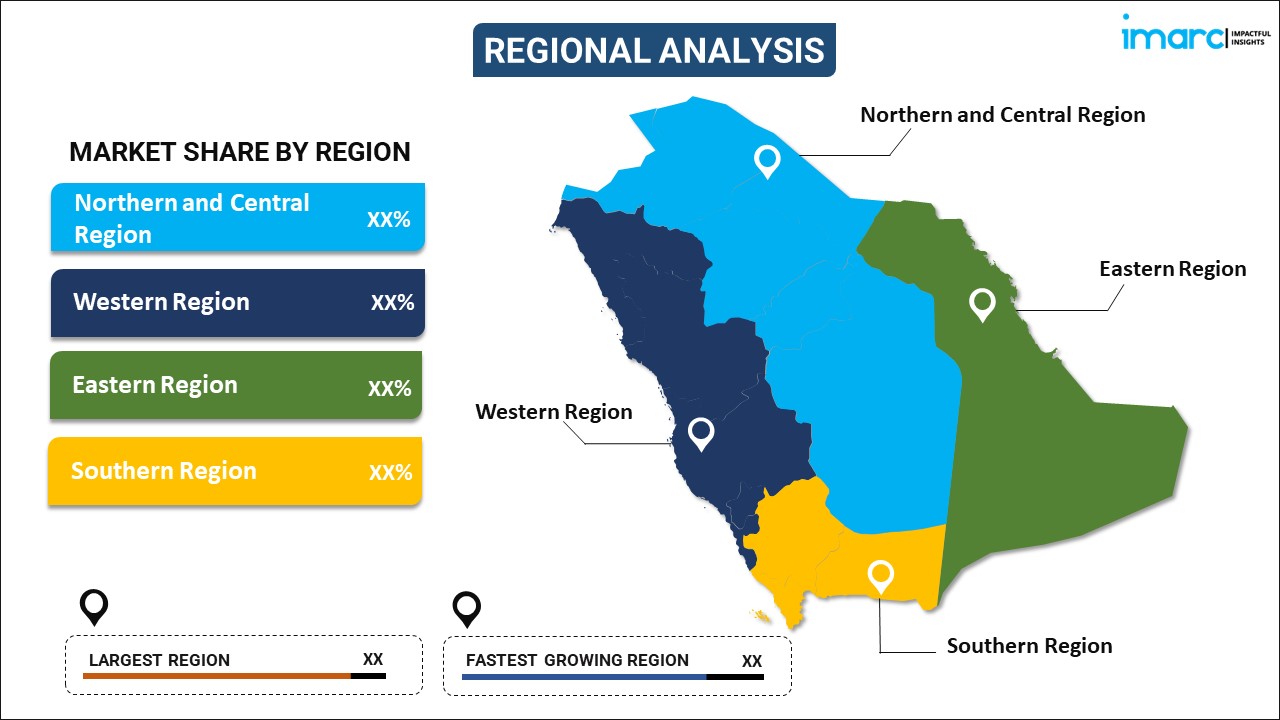
Saudi Arabia Forage Market Report by Crop Type (Cereals, Legumes, Grasses), Product Type (Stored Forage, Fresh Forage), Animal Type (Ruminants, Swine, Poultry, and Others), and Region 2025-2033
Market Overview:
Saudi Arabia forage market size reached USD 800.0 Million in 2024. Looking forward, IMARC Group expects the market to reach USD 1,200.0 Million by 2033, exhibiting a growth rate (CAGR) of 3.30% during 2025-2033. The increasing population, rising demand for livestock products, government emphasis on food security, economic prosperity, ongoing technological advancements, push towards environmental sustainability, and climate resilience represent some of the key factors driving the market.
|
Report Attribute
|
Key Statistics
|
|---|---|
|
Base Year
|
2024
|
|
Forecast Years
|
2025-2033
|
|
Historical Years
|
2019-2024
|
|
Market Size in 2024
|
USD 800.0 Million |
|
Market Forecast in 2033
|
USD 1,200.0 Million |
| Market Growth Rate 2025-2033 | 3.30% |
Forage refers to plant material, primarily grasses, legumes, and other vegetation, consumed by grazing animals such as livestock. It is a vital component of their diet, providing essential nutrients like carbohydrates, proteins, vitamins, and minerals. Typically found in pastures, meadows, or cultivated fields, forage serves as a natural and sustainable source of nourishment for animals, supporting their growth, reproduction, and overall well-being. Forage encompasses a wide variety of plants, ranging from alfalfa and clover to various grass species, each offering distinct nutritional profiles. It is not only crucial for the nutritional needs of livestock but also plays a pivotal role in sustainable agriculture and environmental conservation. It aids in soil health by preventing erosion, promoting biodiversity, and contributing to carbon sequestration. The practice of foraging is integral to pastoral and agrarian societies, where it serves as a foundational element in animal husbandry and contributes to the broader ecological balance within agricultural landscapes.
Saudi Arabia Forage Market Trends:
The Saudi Arabia forage market is experiencing substantial growth, driven by its pivotal role in supporting the country's thriving livestock and agricultural sectors. Besides this, the expanding population, coupled with rising demand for meat and dairy products, spurring the need for high-quality forage to sustain a growing livestock industry, is strengthening the market growth. Moreover, the changing consumer preferences and dietary habits towards a diet rich in animal products are catalyzing the demand for nutritious forage to meet the dietary requirements of livestock, thereby aiding in market expansion. In confluence with this, the government's emphasis on achieving food security and self-sufficiency in livestock feed production has spurred investments in the forage sector, is providing an impetus to the market growth. Concurrently, the inflating disposable incomes of individuals, allowing greater spending on livestock farming, is driving the demand for high-yield and nutritionally dense forage varieties, creating a positive outlook for market expansion. In addition to this, ongoing advancements in agricultural technology and practices, including precision farming and improved forage cultivation techniques, enhancing productivity are influencing the market growth. Furthermore, the widespread product adoption due to their ability to prevent soil erosion, enhance soil fertility, and contribute to carbon sequestration, aligning with the growing awareness of ecological sustainability in agriculture is acting as another significant growth-inducing factor. Apart from this, the globalization of food markets and international trade are bolstering the market growth as Saudi Arabia seeks to diversify its sources of forage and mitigate the impact of fluctuations in global commodity prices.
Saudi Arabia Forage Market Segmentation:
IMARC Group provides an analysis of the key trends in each segment of the market, along with forecasts at the country level for 2025-2033. Our report has categorized the market based on crop type, product type, and animal type.
Crop Type Insights:

- Cereals
- Legumes
- Grasses
The report has provided a detailed breakup and analysis of the market based on the crop type. This includes cereals, legumes, and grasses.
Product Type Insights:
- Stored Forage
- Silage
- Hay
- Fresh Forage
A detailed breakup and analysis of the market based on the product type have also been provided in the report. This includes stored forage (silage and hay) and fresh forage.
Animal Type Insights:
- Ruminants
- Swine
- Poultry
- Others
The report has provided a detailed breakup and analysis of the market based on the animal type. This includes ruminants, swine, poultry, and others.
Regional Insights:

- Northern and Central Region
- Western Region
- Eastern Region
- Southern Region
The report has also provided a comprehensive analysis of all the major regional markets, which include Northern and Central Region, Western Region, Eastern Region, and Southern Region.
Competitive Landscape:
The market research report has also provided a comprehensive analysis of the competitive landscape in the market. Competitive analysis such as market structure, key player positioning, top winning strategies, competitive dashboard, and company evaluation quadrant has been covered in the report. Also, detailed profiles of all major companies have been provided.
Saudi Arabia Forage Market Report Coverage:
| Report Features | Details |
|---|---|
| Base Year of the Analysis | 2024 |
| Historical Period | 2019-2024 |
| Forecast Period | 2025-2033 |
| Units | Million USD |
| Scope of the Report | Exploration of Historical and Forecast Trends, Industry Catalysts and Challenges, Segment-Wise Historical and Predictive Market Assessment:
|
| Crop Types Covered | Cereals, Legumes, Grasses |
| Product Types Covered |
|
| Animal Types Covered | Ruminants, Swine, Poultry, Others |
| Regions Covered | Northern and Central Region, Western Region, Eastern Region, Southern Region |
| Customization Scope | 10% Free Customization |
| Post-Sale Analyst Support | 10-12 Weeks |
| Delivery Format | PDF and Excel through Email (We can also provide the editable version of the report in PPT/Word format on special request) |
Key Questions Answered in This Report:
- How has the Saudi Arabia forage market performed so far and how will it perform in the coming years?
- What has been the impact of COVID-19 on the Saudi Arabia forage market?
- What is the breakup of the Saudi Arabia forage market on the basis of crop type?
- What is the breakup of the Saudi Arabia forage market on the basis of product type?
- What is the breakup of the Saudi Arabia forage market on the basis of animal type?
- What are the various stages in the value chain of the Saudi Arabia forage market?
- What are the key driving factors and challenges in the Saudi Arabia forage?
- What is the structure of the Saudi Arabia forage market and who are the key players?
- What is the degree of competition in the Saudi Arabia forage market?
Key Benefits for Stakeholders:
- IMARC’s industry report offers a comprehensive quantitative analysis of various market segments, historical and current market trends, market forecasts, and dynamics of the Saudi Arabia forage market from 2019-2033.
- The research report provides the latest information on the market drivers, challenges, and opportunities in the Saudi Arabia forage market.
- Porter's five forces analysis assist stakeholders in assessing the impact of new entrants, competitive rivalry, supplier power, buyer power, and the threat of substitution. It helps stakeholders to analyze the level of competition within the Saudi Arabia forage industry and its attractiveness.
- Competitive landscape allows stakeholders to understand their competitive environment and provides an insight into the current positions of key players in the market.
Need more help?
- Speak to our experienced analysts for insights on the current market scenarios.
- Include additional segments and countries to customize the report as per your requirement.
- Gain an unparalleled competitive advantage in your domain by understanding how to utilize the report and positively impacting your operations and revenue.
- For further assistance, please connect with our analysts.
 Request Customization
Request Customization
 Speak to an Analyst
Speak to an Analyst
 Request Brochure
Request Brochure
 Inquire Before Buying
Inquire Before Buying




.webp)




.webp)












